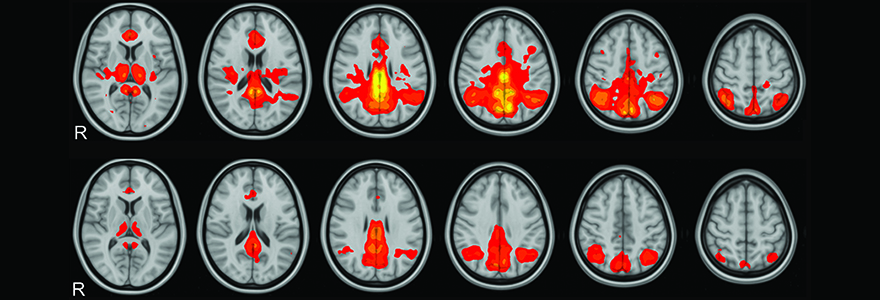Pieces of the Puzzle
 For every question that concussion research answers, it raises a dozen more. Researchers are drawing upon their unique areas of expertise to illuminate the ways that concussions impact the brain and explore potential solutions.
For every question that concussion research answers, it raises a dozen more. Researchers are drawing upon their unique areas of expertise to illuminate the ways that concussions impact the brain and explore potential solutions.
By Ashley Rabinovitch
Ravi Menon, PhD, never ceases to marvel at the brain’s capacity to change and adapt. For the past seven years, the MRI neurophysicist and Medical Biophysics Professor has employed ultra-high field MRI technology at Robarts Research Institute to map the effects of blunt trauma in elite teams of hockey and rugby players. More often than not, he is as surprised as the athletes he studies to discover the results.
In a recent pair of studies, Menon compared the brain scans of rugby players to scans of athletes in non-contact sports like rowing and swimming. In both concussed and non-concussed players, the scans of rugby players indicated significant structural and functional changes to the brain.
“It was a real eye opener,” he said. “Players get hit in the head in different ways, but we see common damage in the longest fibres that connect different parts of the brain.”
In another study, Menon discovered similar brain damage in scans of hockey players who had experienced a concussion. Their symptoms subsided after several weeks, but their brain scans told a different story.
Despite the strong correlation between concussions and changes in the structure and function of the brain, the long-term persistence of these changes remains unclear.
“Our hunch is that between 10 and 15 per cent of people who have concussions will experience lifelong effects,” said Menon. “We worry that once the brain hits its limit in terms of how much it can reorganize itself, these people will be more prone to diseases like Alzheimer’s and Parkinson’s.”
At the same time, Adrian Owen, PhD, is exploring the effects of concussion through the lens of cognition.
Upon moving to Canada from the United Kingdom, Owen, who is a Professor and scientist, identified the potential for concussion research given the popularity of high-impact sports. It occurred to him that the same cognitive testing his lab used to study patients with neurogenerative diseases could also uncover the effects of concussion on cognition.
“We worry that once the brain hits its limit in terms of how much it can reorganize itself, these people will be more prone to diseases like Alzheimer’s and Parkinson’s.”
—Ravi Menon, PhD
As a starting point, Owen recruited a group of 20,000 people within the general population to participate in a battery of web-based tests to assess memory, reasoning and perception. He found that those who had suffered a concussion performed normally in 11 out of 12 categories, but the final test indicated a significant impairment in a test for inhibitory control.
Owen then tested a group of varsity football players, not knowing if any had experienced a concussion, to find out how they compared to the larger group. Surprisingly, the football players performed normally on the same 11 tests and poorly on the test of inhibitory control.
“Knowing how easy it is to sustain a brain injury, I thought we would see a broader set of deficits than we did,” Owen admitted. “Nevertheless, it’s important to recognize that lowered inhibition can profoundly affect someone’s everyday life; from not being able to hold a proper conversation to running a traffic light or getting into a fight.”
Intrigued by the insights his testing system has yielded, Owen plans to explore the connection between concussion and neurodegenerative diseases in future studies. He will also consider strategies for restoring lost cognitive function in a brain that has experienced a concussion. “We’re gradually moving in that direction by using the same test of inhibitory control as a training tool,” he said. “It’s a work in progress.”
While Menon and Owen focus their efforts on identifying the changes the brain undergoes in response to a concussion, Arthur Brown, PhD, is pioneering therapeutic strategies to address these changes using his knowledge of nervous system regeneration.
“I’ve explored the concept of how to regrow nerves for the past 25 years. Several years ago, it occurred to me and several of my colleagues that our research could be relevant to the injured brain, especially in regard to concussions,” said Brown.
Brown, who is a Professor in Anatomy & Cell Biology and scientist at Robarts Research Institute, aims to develop a therapeutic treatment to reduce the inflammation that prevents brain healing.
To that end, he is collaborating with immunologist and fellow Robarts scientist Greg Dekaban, PhD’87, to research ways to treat concussion patients using antibody treatments designed for spinal cord injuries. He is also working to develop medication to interrupt the signals that inhibit nerve growth.
“Until recently, we didn’t have much data around concussions or any way to understand the mechanics of how they affect the brain,” he said. “Given the strength of concussion research at Western, I now have colleagues who can help answer these questions and pave the way for effective treatment.”
Though his research is still in a “stage of infancy,” Brown is spurred on by the potential for large-scale impact.
“I’ve personally benefited from participation in sports, but our society is rightfully concerned about the long-term risks,” he said. “At the same time, the connection between concussions and long-term conditions like Alzheimer’s will have major only way to confront these problems is to figure out better ways to identify and treat concussions. We still have more questions than answers, but we’re slowly putting together the pieces of the puzzle.”








